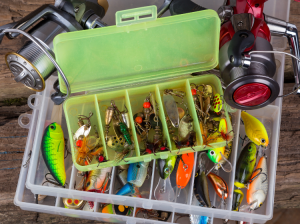For those new to the world of fishing, the sheer variety of tackle available can be overwhelming. Understanding the essentials and making informed choices is key to starting the angling journey on the right foot.
In the latest episode of the Angler News SA podcast’s Expert Series, Vinesh Soogreem and John Otto, an experienced angler, share valuable advice on selecting the right fishing gear. A crucial takeaway from the discussion is the importance of building relationships with local tackle shops. Forming these connections can help avoid costly mistakes and ensure that beginners receive personalized guidance suited to their needs.
The episode also highlights the benefits of seeking advice from trusted salespeople. Their expertise can help beginners navigate the numerous options, steering them towards quality products and helping them avoid common pitfalls. The discussion extends to the pros and cons of purchasing cheap tackle online, providing listeners with insights into whether these deals are worth the risk.
Meanwhile, another common concern among anglers is fishing in bad weather. Contrary to popular belief, poor weather conditions do not necessarily mean fishing plans have to be canceled. Expert angler Ray Thompson explains that fishing during challenging weather can present unique opportunities. Fish often become more active in rough conditions, increasing the chances of a successful catch. In a conversation with Vinesh Soogreem, Thompson shares tips on how to turn a seemingly unfavorable fishing day into a productive one. His experience with catching species like the Honeycomb Skate in rough, dirty water highlights the potential for success, even in tough conditions.

In a previous episode of the Expert Series, Vinesh explored the best-eating fish found in South African waters. Joined by Brett and Daryl Bartho, owners of Bartho’s Fish Company, the discussion centered on the finest seafood available and how to handle and cook it properly. Among the top recommendations were:
- Cape Salmon: Known for its tender flesh and mild flavor, Cape salmon is a favorite among seafood lovers.
- Kob: With firm, white meat and a slightly sweet taste, kob is a versatile fish often grilled or pan-fried.
- Yellowtail: This species is praised for its rich flavor and firm texture, making it ideal for grilling or sashimi.
When purchasing fish, the Bartho brothers emphasized the importance of selecting fresh catches. Bright eyes, firm flesh, and a pleasant seafood smell are telltale signs of quality. To maintain the integrity of the fish, proper handling is crucial—overhandling can lead to bruising and a loss of quality. For storage, refrigerating or freezing the fish ensures freshness until it’s ready to be cooked.
For cooking, they suggested several methods:
- Grilling: This classic approach brings out the fish’s natural flavors while adding a smoky taste.
- Baking: A healthier cooking method, baking preserves the fish’s moisture and flavor.
- Pan-Frying: A quick and simple way to prepare smaller fish cuts, pan-frying ensures a crispy exterior.
Listeners interested in learning more about these topics can find full episodes of the Angler News SA podcast on their preferred platform.
Meet Vinesh Soogreem
Vinesh Soogreem has become a prominent figure in the South African fishing media landscape. With more than 20 years of experience, Vinesh is not only an accomplished angler, having explored the waters of KwaZulu-Natal (KZN) extensively, but also a passionate advocate for responsible fishing and conservation. His motto, “Fish for the future,” reflects his commitment to preserving marine ecosystems for future generations.
In addition to his achievements in angling, Vinesh has contributed significantly to the fishing community through his work in books, magazines, podcasts, and social media. He currently serves as the National Media Liaison for the South African Surf Casting Association, further cementing his status as a key player in the South African fishing scene.
Image/Source: ecr





